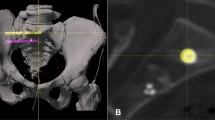Abstract
Purpose
Image guidance is essential in some orthopedic surgical procedures, especially iliosacral screw fixation. Currently, there is no consensus regarding the best image guidance technique. An ex-vivo study was performed to compare conventional, 2-dimensional (2D), and 3D imaging techniques and determine the optimal image guidance technique for pelvic surgery.
Methods
Plastic (n = 9) and donated cadaver pelvises (n = 8) were evaluated in the laboratory. The pelvises were positioned on radiolucent operation tables in a prone position. Transiliosacral screws were inserted without or with 2D- and 3D-navigational support. A digital mobile X-ray unit with flat-panel fluoroscopy and navigation software was used to measure precision, radiation exposure, and time requirements.
Results
2D-navigation resulted in 40% incorrect screw positioning for the cadavers, 6% for the plastic phantoms, and 21% overall. The highest accuracy was accomplished with 3D-navigation (plastic: 100%; cadavers: 83%; p < 0.05). The dose-area product showed that both 2D- and 3D-navigation required increased exposure compared to the conventional technique (p < 0.01). For both plastic and cadaver specimens, navigated techniques required significantly longer times for screw insertion than the conventional technique (p < 0.01).
Conclusion
3D image guidance for transiliosacral screw fixation enabled more accurate screw placement in S1 and S2 vertebrae. However, radiation exposure in 3D-navigation was excessive; thus, we recommend avoiding 3D-navigation in young patients. A primary advantage of 3D-navigation was that the operating team could leave the room during the scan; thus, it reduced their radiation exposure. Moreover, the time required for screw insertion with 3D-navigation was similar to that required in the conventional technique; thus, 3D-navigation is recommended for older patients.
Similar content being viewed by others
References
Krettek C, Gebhard F, Hufner T (2003) The current status of navigation systems. Unfallchirurg 106(11): 897–898
Schnake KJ, Konig B, Berth U, Schroeder RJ, Kandziora F, Stockle U, Raschke M, Haas NP (2004) Accuracy of CT-based navigation of pedicle screws in the thoracic spine compared with conventional technique. Unfallchirurg 107(2): 104–112
Schlenzka D, Laine T, Lund T (2000) Computer-assisted spine surgery: principles, technique, results and perspectives. Orthopade 29(7): 658–669
Schlenzka D, Laine T, Lund T (2000) Computer-assisted spine surgery. Eur Spine J 9(Suppl 1): S57–S64
Reichle E, Sellenschloh K, Morlock M, Eggers C (2002) Placement of pedicle screws using different navigation systems. A laboratory trial with 12 spinal preparations. Orthopade 31(4): 368–371
Briem D, Windolf J, Rueger JM (2007) Percutaneous, 2d-fluoroscopic navigated iliosacral screw placement in the supine position: technique, possibilities, and limits. Unfallchirurg 110(5): 393–401
Stockle U, Schaser K, Konig B (2007) Image guidance in pelvic and acetabular surgery-expectations, success and limitations. Injury 38(4): 450–462
Briem D, Rueger JM, Begemann PG, Halata Z, Bock T, Linhart W, Windolf J (2006) Computer-assisted screw placement into the posterior pelvic ring: assessment of different navigated procedures in a cadaver trial. Unfallchirurg 109(8): 640–646
Zwingmann J, Konrad G, Kotter E, Sudkamp NP, Oberst M (2009) Computer-navigated iliosacral screw insertion reduces malposition rate and radiation exposure. Clin Orthop Relat Res 467(7): 1833–1838
Citak M, Hufner T, Geerling J, Kfuri M Jr., Gansslen A, Look V, Kendoff D, Krettek C (2006) Navigated percutaneous pelvic sacroiliac screw fixation: Experimental comparison of accuracy between fluoroscopy and iso-c3d navigation. Comput Aided Surg 11(4): 209–213
Smith HE, Welsch MD, Sasso RC, Vaccaro AR (2008) Comparison of radiation exposure in lumbar pedicle screw placement with fluoroscopy vs computer-assisted image guidance with intraoperative three-dimensional imaging. J Spinal Cord Med 31(5): 532–537
Kalender WA, Kyriakou Y (2007) Flat-detector computed tomography (fd-ct). Eur Radiol 17(11): 2767–2779
Schaefer-Prokop C, Uffmann M, Sailer J, Kabalan N, Herold C, Prokop M (2003) Digital thorax radiography: flat-panel detector or storage phosphor plates. Radiologe 43(5): 351–361
Kyriakou Y, Kalender WA (2007) X-ray scatter data for flat-panel detector CT. Phys Med 23(1): 3–15
Richter G, Engelhorn T, Struffert T, Doelken M, Ganslandt O, Hornegger J, Kalender WA, Doerfler A (2007) Flat panel detector angiographic CT for stent-assisted coil embolization of broad-based cerebral aneurysms. AJNR Am J Neuroradiol 28(10): 1902–1908
Grampp S (2002) Flat panel detector systems in skeletal radiology. Wien Med Wochenschr Suppl (113): 12–14
Imhof H, Dirisamer A, Fischer H, Grampp S, Heiner L, Kaderk M, Krestan C, Kainberger F (2002) Change in process management by implementing ris, pacs and flat-panel detectors. Radiologe 42(5): 344–350
Daly MJ, Siewerdsen JH, Moseley DJ, Jaffray DA, Irish JC (2006) Intraoperative cone-beam CT for guidance of head and neck surgery: assessment of dose and image quality using a c-arm prototype. Med Phys 33(10): 3767–3780
Zwienen CM, van Bosch EW, van den Snijders CJ, Kleinrensink GJ, van Vugt AB (2004) Biomechanical comparison of sacroiliac screw techniques for unstable pelvic ring fractures. J Orthop Trauma 18(9): 589–595
Matta JM, Tornetta P III (1996) Internal fixation of unstable pelvic ring injuries. Clin Orthop Relat Res 329: 129–140
Konrad G, Zwingmann J, Kotter E, Sudkamp N, Oberst M (2009) Variability of the screw position after 3d-navigated sacroiliac screw fixation : influence of the surgeon’s experience with the navigation technique. Unfallchirurg 113: 29–35
Hufner T, Kendoff D, Citak M, Geerling J, Krettek C (2006) Precision in orthopaedic computer navigation. Orthopade 35(10): 1043–1055
Arand M, Kinzl L, Gebhard F (2002) Sources of error and risks in ct based navigation. Orthopade 31(4): 378–384
Tosounidis G et al (2007) Percutaneous sacroiliac lag screw fixation of the posterior pelvic ring. Increasing safety by standardization of visualization and insertion technique. Unfallchirurg 110(8): 669–674
Routt ML Jr, Nork SE, Mills WJ (2000) Percutaneous fixation of pelvic ring disruptions. Clin Orthop Relat Res 375: 15–29
Stockle U, Krettek C, Pohlemann T, Messmer P (2004) Clinical applications—pelvis. Injury 35(Suppl 1): S-A46–S-A56
Hufner T, Geerling J, Gansslen A, Kendoff D, Citak C, Grutzner P, Krettek C (2004) Computer-assisted surgery for pelvic injuries. Chirurg 75(10): 961–966
Author information
Authors and Affiliations
Corresponding author
Rights and permissions
About this article
Cite this article
Behrendt, D., Mütze, M., Steinke, H. et al. Evaluation of 2D and 3D navigation for iliosacral screw fixation. Int J CARS 7, 249–255 (2012). https://doi.org/10.1007/s11548-011-0652-7
Received:
Accepted:
Published:
Issue Date:
DOI: https://doi.org/10.1007/s11548-011-0652-7




